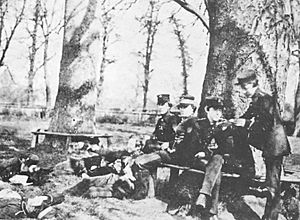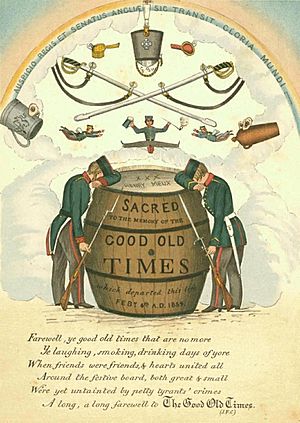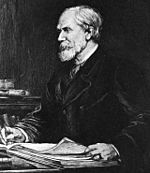Addiscombe Military Seminary facts for kids
Quick facts for kids Addiscombe Military Seminary |
|
|---|---|

East front of Addiscombe Place, the main building of Addiscombe Seminary, photographed c.1859. Cadets pose in the foreground. The inscription Non faciam vitio culpave minorem can be seen on the entablature
|
|
| Active | 1809–1861 |
| Country | |
| Branch | |
| Type | Training |
| Role | Army Officer Training |
| Garrison/HQ | Addiscombe, Surrey |
The East India Company Military Seminary was a special school in Addiscombe, Surrey, in what is now part of London. It was a military academy that opened in 1809 and closed in 1861. Its main goal was to train young officers. These officers would then serve in the East India Company's own army in India.
The school had a few different names over the years. It was first called the East India Company Military Seminary. In 1855, its name changed to the East India Company Military College. Later, in 1858, the government took over the college. It was then renamed the Royal India Military College. People often called it Addiscombe Seminary or Addiscombe College for short.
This seminary was like a sister school to the East India Company College in Hertfordshire. That college trained people for civilian jobs, like clerks. In the military world, Addiscombe was similar to the famous Royal Military Academy, Woolwich and the Royal Military College, Sandhurst.
Contents
History of Addiscombe Military College
The story of Addiscombe Military College begins with a grand house.
Addiscombe Place: The Original Mansion
The main building of the seminary was a large house called Addiscombe Place. It was built around 1702 by William Draper. His relative, the famous diarist John Evelyn, said it was one of the best houses in Surrey. The inside had many paintings of old myths. On the outside, above the main entrance, there was a Latin message. It said, Non faciam vitio culpave minorem, which means "I will not lower myself by vice or fault."
Later, in the late 1700s, a statesman named Charles Jenkinson, 1st Earl of Liverpool lived there. Important visitors like King George III and William Pitt the Younger often came to the house.
Founding the Military Seminary
After Lord Liverpool passed away in 1808, Addiscombe Place was put up for sale. The East India Company decided to buy it. Even though the company was mostly about trade, it had its own army in India. Before this, their officers were trained at other military schools or privately. Now, they would be trained at Addiscombe.
The Seminary officially opened on January 21, 1809. At first, the company bought the mansion and about 58 acres of land. Later, they bought another 30 acres. New buildings were added over time. The original mansion then became mostly for offices. New additions included barracks for students, a chapel, classrooms, a hospital, and a dining hall. There were also places for practical training and daily services like a bakery.
Life and Learning for Cadets
Young men joined the Seminary as cadets. In the early days, they were between 13 and 16 years old. Later, the age range changed to 15 to 18. They usually stayed for two years, which was four terms. About 150 cadets lived there at any one time. Families paid fees, but the education was heavily supported by the company.
At first, the school mainly trained cadets for the Engineer or Artillery branches of the army. These were specialized roles. Later, from 1827, cadets for the Infantry (foot soldiers) were also accepted. In total, about 3,600 cadets trained at Addiscombe. Many became engineers, artillery officers, or infantry officers.
The cadets studied many subjects. These included mathematics, how to build forts (fortification), science, and chemistry. They also learned languages like Hindustani, Latin, and French. Drawing, surveying, and building gun parts were also part of the training. The school had excellent teachers. For example, John Shakespear wrote a famous Hindustani grammar book. The main focus was on mathematics. Some people thought the school needed more practical military training. In the 1850s, photography was also taught.
Cadets had to wear uniforms all the time. They were not allowed to leave the school grounds without permission. However, they sometimes got into trouble. Fights with people from the nearby town of Croydon were not uncommon. There was no physical punishment. In the early years, cadets could be put in a "Black Hole" and given only bread and water as punishment.
Exams and Awards
Exams were held twice a year, in June and December. They lasted about three weeks. The most important part was the Public Examination. This was a big event with a special audience. Cadets showed off what they learned, including military exercises like swordsmanship and building temporary bridges. There was also an exhibition of drawings and models. A famous general would lead the examination. Important guests, like the Directors of the East India Company and sometimes even the Archbishop of Canterbury, would attend.
In 1848, the Seminary started giving out the Pollock Medal. This medal was for the best cadet of the training season. It was named after Field Marshal Sir George Pollock. When Addiscombe closed, the Pollock Prize was moved to the Royal Military Academy, Woolwich.
Closing of the College
After the Indian Rebellion of 1857, the East India Company was closed down in 1858. The college then became government property. It was renamed the Royal Indian Military College, Addiscombe. It continued to train officers for a short time.
However, in 1861, the British government decided they had enough military colleges at Woolwich and Sandhurst. So, Addiscombe Military College closed its doors in June 1861.
The land was sold in 1861. Most of the buildings were torn down. Only a few parts remain today. Two former professors' houses, "Ashleigh" and "India," can still be seen. The old gymnasium is now private apartments. The land was turned into new roads and houses. The new roads were named after famous British soldiers and politicians from the time, like Outram, Havelock, and Clyde.
Leaders of the College
The college had several important leaders:
- 1809–22: James Andrew, called Superintendent and Head Master
- 1822–24: Henry Carmichael-Smyth, Resident Superintendent
- 1824–34: Sir Robert Houston, Lieutenant-Governor
- 1834–50: Sir Ephraim Stannus, Lieutenant-Governor
- 1851–60: Sir Frederick Abbott, Lieutenant-Governor
Famous Cadets of Addiscombe
Many cadets who trained at Addiscombe went on to have important careers. Here are some of the most well-known:

Many other cadets also became important figures in the military and government. Some even received the Victoria Cross, a very brave award.
Notable Staff and Examiners
The college had many talented teachers and important people who oversaw the exams.
Some of the notable staff included:
- Sir Frederick Abbott, Lieutenant-Governor
- Dr James Andrew, Superintendent
- Revd Jonathan Cape, Senior Professor of Mathematics
- John Frederic Daniell, Professor of Chemistry
- Edward Frankland, Professor of Chemistry
- John Shakespear, Professor of Hindustani
The Public Examiners, who led the final ceremonies, were also important generals:
- 1809–20: Maj-Gen. William Mudge
- 1820–23: Maj-Gen. Sir Howard Douglas
- 1824–40: Maj-Gen. Sir Alexander Dickson
- 1840–55: Maj-Gen. Charles Pasley
- 1856–61: Maj-Gen. Sir Frederick Smith
Images for kids
See Also
- East India Company College
- Royal Military Academy, Woolwich
- Royal Military College, Sandhurst












